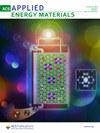Polymorphic Ferroelectricity in Artificially Stacked MoS2 Interfaces
IF 5.4
3区 材料科学
Q2 CHEMISTRY, PHYSICAL
引用次数: 0
Abstract
Original ferroelectricity has been observed in van der Waals (vdW) layered materials, where atomic layer lattice sliding can break the lattice inversion symmetry and induce ferroelectricity. While ferroelectricity in conventional bulk ferroelectric materials, driven by atomic (ionic) displacement for electric polarization, is stable at low temperatures, ferroelectricity in vdW materials has exhibited inconsistent temperature dependences, and its various origins reflecting clean vdW interfaces remain to be clarified. In this study, we demonstrate the unique temperature characteristics of polymorphic ferroelectricity in artificially stacked MoS2 interfaces, probed by transport experiments with edge contacts at various temperatures. In artificially stacked systems with MoS2 multilayers, two types of interface lattice stacking orders can be formed: rhombohedral (R) and hexagonal (H) stacking orders. In R-stacked MoS2, ferroelectricity occurs above a critical temperature T = 210 K, and charge trap behaviors are observed below the critical temperature. However, in H-stacked MoS2, charge trap behaviors dominate the transport above T = 210 K, while ferroelectricity is observed below the critical temperature. The nontrivial temperature dependence of polymorphic ferroelectricity in the R- and H-stacked vdW interfaces can be explained by the distinct roles of thermal energy in the atomic layer lattice sliding and moiré band splitting, paving the way toward advanced applications of polymorphic ferroelectric devices.

人工堆积 MoS2 表面的多态铁电性
在范德华(vdW)层状材料中观察到了原始铁电现象,其中原子层晶格滑动可打破晶格反转对称性并诱发铁电现象。传统块体铁电材料的铁电性由原子(离子)位移驱动电极化,在低温下稳定,而 vdW 材料的铁电性则表现出不一致的温度依赖性,其反映清洁 vdW 界面的各种起源仍有待澄清。在本研究中,我们展示了人工堆叠的 MoS2 界面中多态铁电性的独特温度特性,并通过边缘接触在不同温度下的输运实验进行了探测。在具有 MoS2 多层的人工堆叠系统中,可以形成两种类型的界面晶格堆叠阶:斜方体(R)和六边形(H)堆叠阶。在 R 堆叠的 MoS2 中,铁电性发生在临界温度 T = 210 K 以上,在临界温度以下会出现电荷陷阱行为。然而,在 H 堆叠的 MoS2 中,电荷陷阱行为在 T = 210 K 以上的传输中占主导地位,而在临界温度以下则观察到铁电性。热能在原子层晶格滑动和摩尔带分裂中的不同作用可以解释 R 层和 H 层 vdW 界面中多态铁电性的非三角温度依赖性,从而为多态铁电器件的先进应用铺平了道路。
本文章由计算机程序翻译,如有差异,请以英文原文为准。
求助全文
约1分钟内获得全文
求助全文
来源期刊

ACS Applied Energy Materials
Materials Science-Materials Chemistry
CiteScore
10.30
自引率
6.20%
发文量
1368
期刊介绍:
ACS Applied Energy Materials is an interdisciplinary journal publishing original research covering all aspects of materials, engineering, chemistry, physics and biology relevant to energy conversion and storage. The journal is devoted to reports of new and original experimental and theoretical research of an applied nature that integrate knowledge in the areas of materials, engineering, physics, bioscience, and chemistry into important energy applications.
 求助内容:
求助内容: 应助结果提醒方式:
应助结果提醒方式:


